In many Unix-like environments the terminal/command-line defaults are
very different from the systems Qodem and Qmodem were originally
designed to communicate with. These issues are described in detail
below. Qodem has programmatic solutions to most of these issues,
however one issue remains important: the text version of Qodem needs a
good font to look right.
Qodem strives to be faithful to the DOS-based Qmodem, however
computers have changed significantly since the days of DOS. This
guide is meant to help make a new user's experience with Qodem better.
Getting Qodem to work well on a stock Linux or Mac installation
involves checking several things:
- Screen - Qodem needs at least 80 columns by 25 rows and white text
on black background.
- Font - Qodem needs a Unicode font that includes both the CP437
glyphs and the DEC multinational character sets.
- Keyboard - Qodem uses several function keys that modern
environments often co-opt for other functions. Qodem will respond
to other keystrokes if the function keys are unavailable. Also,
Qodem needs the Alt or Meta key to send a separate escape character,
NOT set the 8th bit.
- Locale - Qodem needs both a Unicode locale and a non-Unicode
locale to use when spawning shells and connecting to other Unix-like
systems.
- Other Qodem options - the Qodem options file may need to be edited
further for a specific environment.
These items each have their own detailed sections below. Most of
these things are due to how distributions set up their terminals
differently from the raw Linux console. And the end is a section
describing the setup I use.
But assuming that everything is set up well, how should Qodem work on
its first run? That is the subject of the next section.
When Qodem runs for the first time, it will do several things:
-
It will create several directories. On Unix-like systems, these
are
~/.qodem, ~/.qodem/scripts,
~/qodem, and ~/qodem/host; on Windows,
these are My Documents\qodem\prefs, My
Documents\qodem\host, and My
Documents\qodem\script. These directories are used to store
configuration files, user-generated and Quicklearn-generated
scripts, downloaded files, and host mode messages and files.
-
On Unix-like systems, it will also create a FIFO (named pipe file)
at
~/.qodem/scripts/script.stderr. This file is used
to route a script's stderr stream to the display.
-
Qodem will populate
~/.qodem with several files,
including the Qodem options file (~/.qodem/qodemrc
or My Documents\qodem\prefs\qodemrc.txt). The options
file is a plain text file and can be edited by hand or by typing
Alt-N in terminal mode. Blank lines and lines beginning with '#'
are ignored. Every option has a description and a default value.
If the options file is deleted, it will be re-created with defaults
the next time Qodem runs.
Qodem will start in the phonebook screen:

The bottom line shows the status line. This line updates through most
of the Qodem screens to provide hints on which actions are available.
Qodem populates its first phonebook with an entry for the local
system, several bulletin boards, and some other terminal systems.
From this point you can navigate to an entry and press Enter to
connect.
Adding a new system to the phonebook is straightforward: press the
Insert key or 'I' to see the new/revise entry screen:
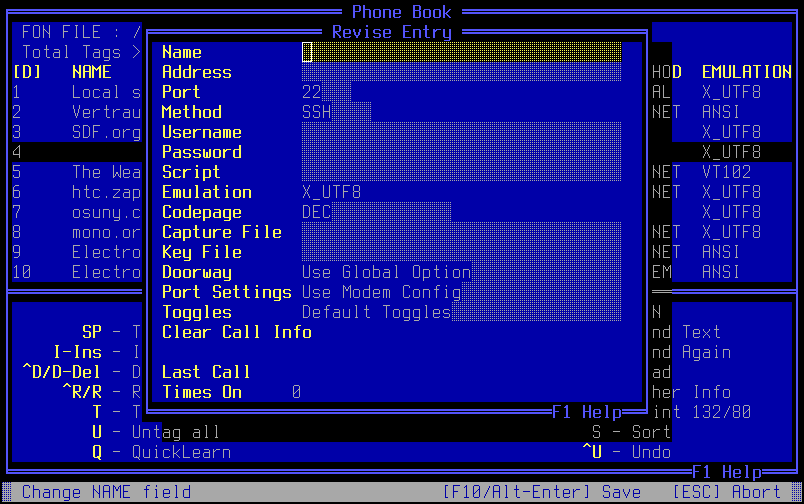
Use the arrow keys to navigate between fields, the status line will
update with each field. Some fields require selecting from a list,
press F2 or the space bar to bring up the list and F10 or Enter to
select the option. For this example, use the LOCAL method and X_UTF8
emulation:
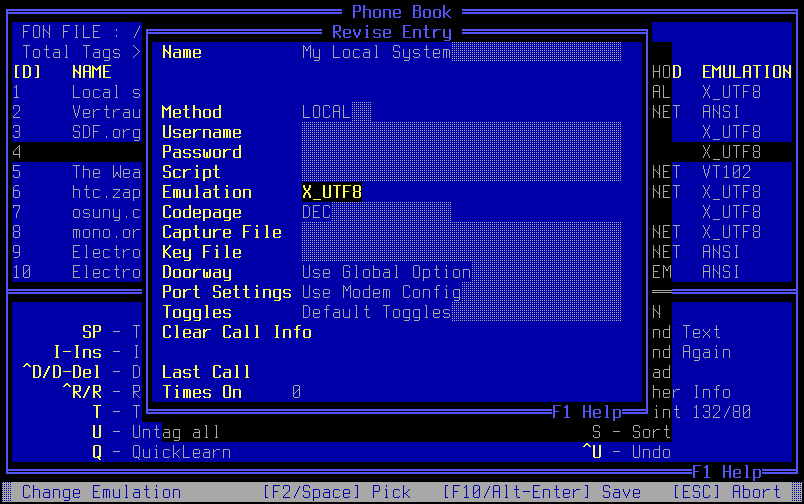
After you have gotten the entry set up, press F10 or Alt-Enter to save
the entry:
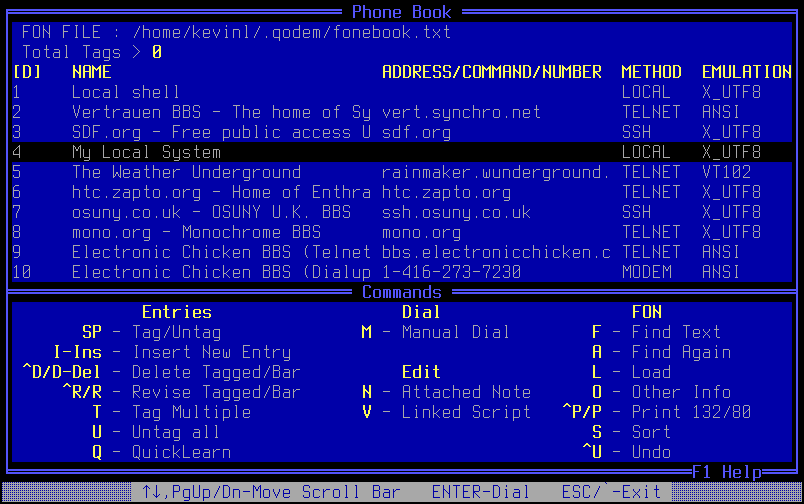
Press Enter again to dial the entry and it will switch to terminal
mode:
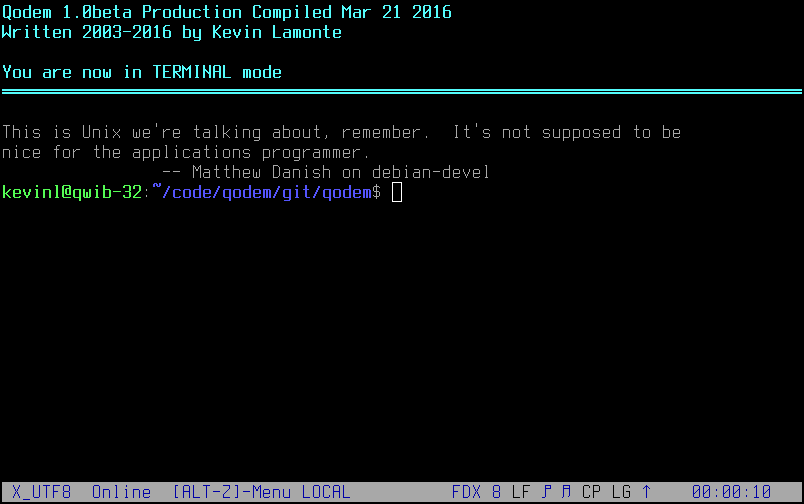
In terminal mode most keystrokes are passed to the remote system (in
this case, the spawned shell). Pressing Alt-Z brings up a menu of
other keystrokes:
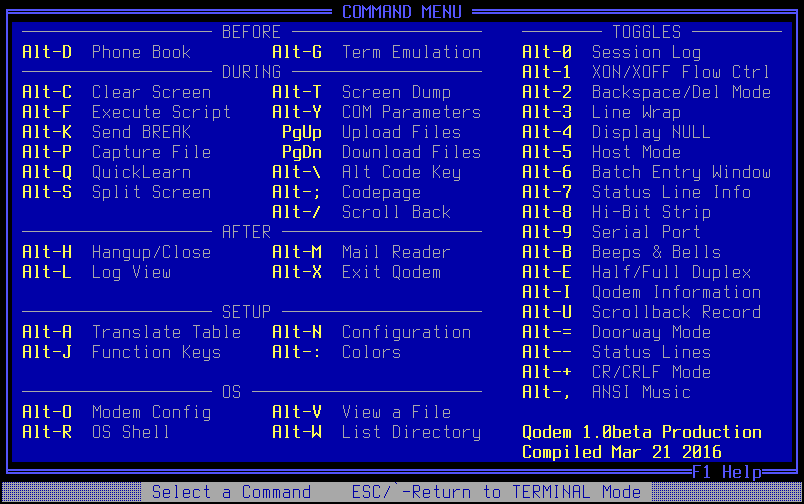
When ready to exit Qodem, press Alt-X while in terminal mode (or
Ctrl-C if Qodem is offline) to bring up the exit
dialog:
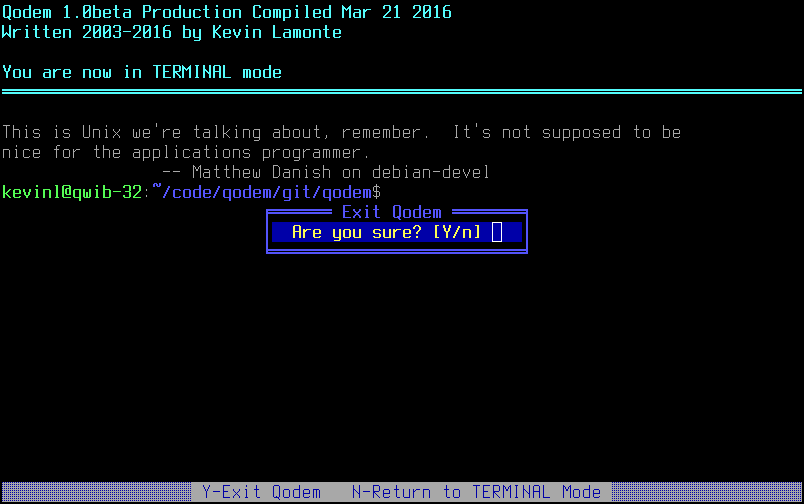
When you are ready to explore more BBS systems, press 'L' in the
phonebook and use arrow keys to select the Telnet BBS Guide list of
systems:
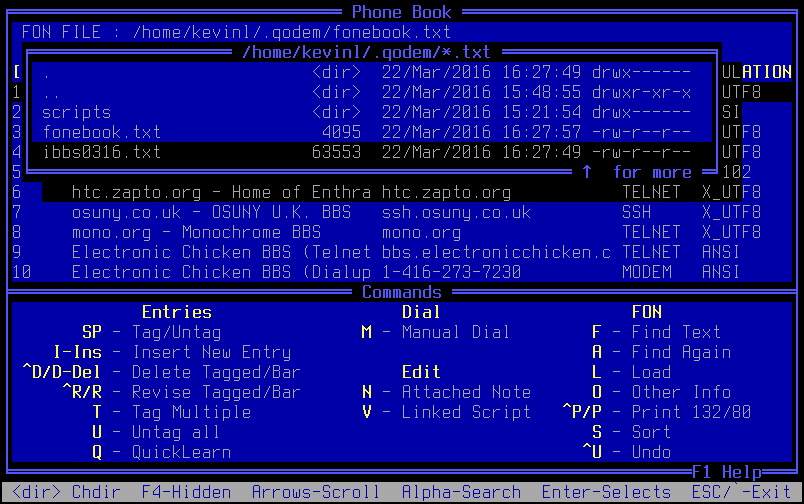
Press Enter to load the list:
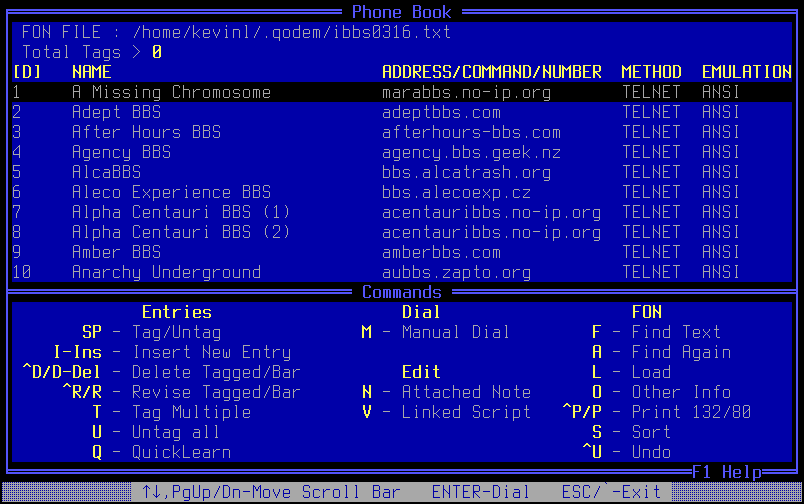
Now go telnet away and enjoy!
If you would like to change Qodem's colors, edit
the colors.cfg file in the preferences directory. The
original Qmodem(tm) 5.0 themes are all present, simply remove the '#'
to uncomment those lines. See below for shots of the Purple, Red, and
Custom themes.
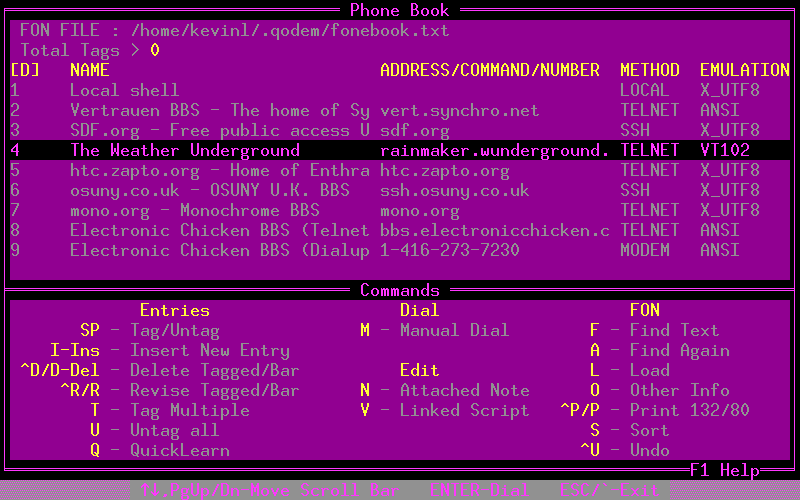
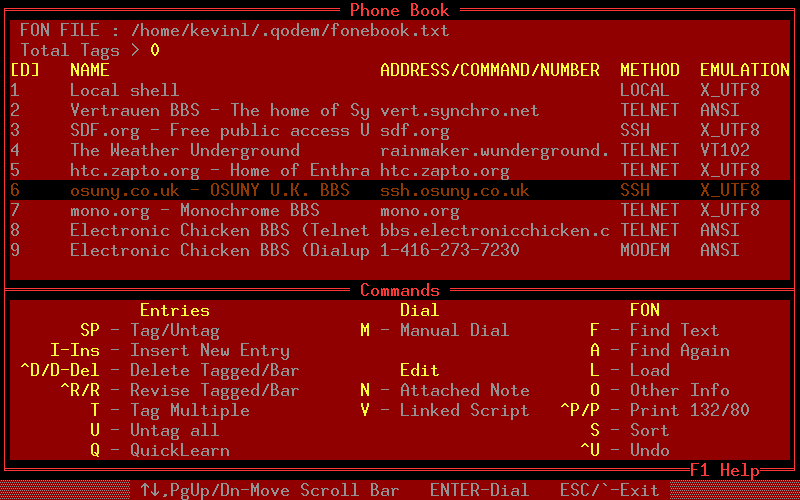
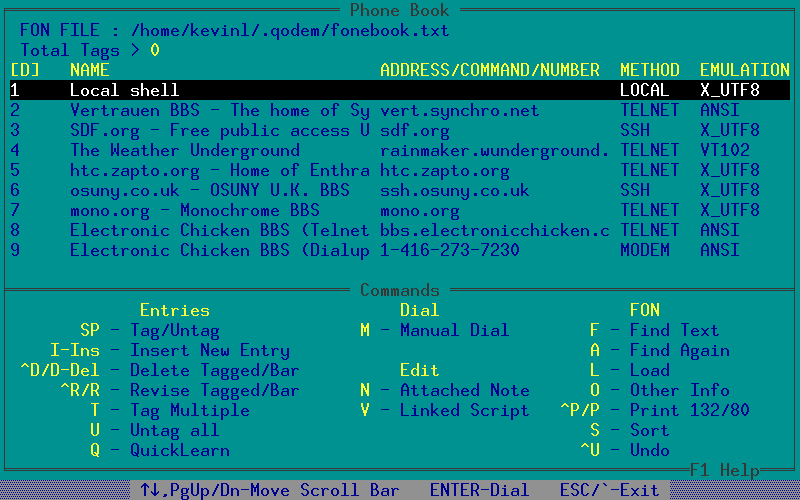
Qodem needs at least 80 columns by 25 rows (80x25). Most X11
terminals are configured for 80x24 by default and will need to be
changed. Several options are available:
- Pass "-geometry 80x25" on the terminal program's command
line.
- Configure the terminal through its menu interface to use 80x25 or
larger.
Qodem requires a Unicode font that includes glyphs from the CP437 and
DEC multinational character sets. Some good fonts to use are:
- Terminus. Some VT100 line-drawing characters may be missing, but
CP437 coverage is very good.
- uni_vga. This is the default Linux console font (what one gets
from executing 'setfont' with no arguments). You can download
uni_vga including a version converted to TrueType
at this link.
- Unifont. Generally looks OK, but some of the VT100 line-drawing
characters are not very pretty.
- The default font on Mac OSX Terminal.app.
Unfortunately, no single font solves the issue best. The only font
that seems to have every needed glyph and looks very good is uni_vga,
however uni_vga can be small-and-sharp or larger-and-blurry on modern
displays. The second best is Terminus: it looks very good and is only
missing a handful of VT100 graphics glyphs that are very rarely used.
Qodem needs the keyboard to send the ESCape character for the Alt/Meta
key. Many X11 terminals are configured for the Alt/Meta key to set
the 8th bit by default and will need to be changed. Several options
are available:
- Configure the terminal through its menu interface to send the
ESCape key. On Mac Terminal.app look for the option labeled "Use
option as meta key" in "Preferences → Settings → Keyboard"
(Leopard 10.5 / Snow Leopard 10.6) or "Window Settings →
Keyboard" (Tiger 10.4).
- Use uxterm, and add these lines to ~/.Xresources:
XTerm*eightBitInput: true
XTerm*metaSendsEscape: true
UXTerm*eightBitInput: true
UXTerm*metaSendsEscape: true
You can verify that the Alt/Meta key is sending ESCape by running
'cat' in the shell and typing Alt-X, you should see multiple
characters (typically ^[x, maybe ←x)
instead of one.
Locales are a complex issue for Qodem:
- The locale of the terminal/console that Qodem uses to display
glyphs to the user at the keyboard MUST be UTF-8. If it isn't,
Qodem will look very ugly and might not handle keyboard input
correctly either.
- When Qodem connects to remote systems, the code page of those
systems depends on the terminal emulation:
- TTY, DEBUG, ANSI, Avatar, LINUX, and XTERM emulations use 8 bit
characters and can have different code pages for the high-bit
characters. Qodem currently supports many DOS and Windows codepages
including CP437, CP850, KOI8-R/U, Windows 1250/1251/1252,
ISO-8859-1, and more.
- VT52, VT100, and VT102 emulations are defined by their standards
to be 7-bit only, so only ASCII characters and DEC Special Graphics
characters will be seen.
- VT220 emulation uses 8-bit characters but has multiple defined
code pages for the high-bit characters (DEC multinational
characters).
- L_UTF8 and X_UTF8 use UTF-8 encoded characters throughout.
- ATASCII and PETSCII have custom 8-bit encodings that are not quite
ASCII. PETSCII in particular also needs the C64 Pro Mono font from
Style.
- When the remote system is a Unix-like system, the LANG environment
variable must be set correctly to get the remote system to send
either 8-bit characters or UTF-8 encoded characters.
Much of this complexity arises due to Qodem's niche: it lives between
DOS and Unix-like systems, and uses ncurses for output and gettext for
translation. Getting it right from scratch can be a challenge, but
fortunately the various distributions have made this much easier.
The most straightforward way to handle locales is:
- Ensure you are running a UTF-8 locale by checking the LANG
environment variable in your shell. It should have "UTF-8" in the
value somewhere, e.g. "en_US.UTF-8" .
- Edit
qodemrc (or qodemrc.txt) and ensure
that the value for utf8_lang matches your LANG
environment variable value.
qodemrc also has a iso8859_lang value
that defaults to "C" (no translation). You can put another value
here as long as it does NOT contain UTF-8, e.g. "en_US". If you get
warnings about 'setlocale' then either leave it as "C" or try to add
the locale to your system. On Debian, you can run 'dpkg-reconfigure
locales' to add support for an 8-bit locale.
Right now I run Qodem on Debian with the following packages installed:
xfonts-terminus,
xfonts-terminus-dos, and
xterm.
When I am in X11 I just launch xqodem, which runs Qodem
in a uxterm at 80x25. But when I want a general uxterm for command
line work, I launch uxterm using this shell script:
#!/bin/bash
# uni_vga font
# This font has complete coverage of every glyph and looks great, but
# it is a bit small on large displays. 160x80 on a 1280x800 display.
# exec uxterm -fn -bolkhov-vga-medium-r-normal--16-160-75-75-c-80-iso10646-1
# Terminus font
# This font is small but can cram close to 160x80 on a 1280x800
# display. It is only missing one unusual VT100 special graphics
# glyph.
# exec uxterm -fn -xos4-terminus-medium-r-normal--16-160-72-72-c-80-iso10646-1 -fg white -bg black
# Terminus font
# This font is very nice sized on my 17'' 1280x1024 display at 128x40
# characters. It is only missing a couple of VT100 line drawing
# glyphs.
exec uxterm -fn -xos4-terminus-medium-r-normal--20-200-72-72-c-100-iso10646-1 -fg white -bg black
My ~/.Xresources looks like this:
! XTerm configuration to reproduce DOS colors.
! Credits to Emil Mikulic at http://dmr.ath.cx/notes/xterm.html
xterm*foreground: rgb:a8/a8/a8
xterm*background: rgb:00/00/00
xterm*color0: rgb:00/00/00
xterm*color1: rgb:a8/00/00
xterm*color2: rgb:00/a8/00
xterm*color3: rgb:a8/54/00
xterm*color4: rgb:00/00/a8
xterm*color5: rgb:a8/00/a8
xterm*color6: rgb:00/a8/a8
xterm*color7: rgb:a8/a8/a8
xterm*color8: rgb:54/54/54
xterm*color9: rgb:fc/54/54
xterm*color10: rgb:54/fc/54
xterm*color11: rgb:fc/fc/54
xterm*color12: rgb:54/54/fc
xterm*color13: rgb:fc/54/fc
xterm*color14: rgb:54/fc/fc
xterm*color15: rgb:fc/fc/fc
xterm*boldMode: false
xterm*boldColors: true
xterm*colorBDMode: true
xterm*colorBD: rgb:fc/fc/fc
I ran 'dpkg-reconfigure locales' and selected both 'en_US.UTF-8' and
'en_US' . My LANG environment variable is set to 'en_US.UTF-8'.
My ~/.qodem/qodemrc has
utf8_lang = en_US.UTF-8 and
iso8859_lang = C.
For more information on how Qodem is meant to work, refer to any of
these:












